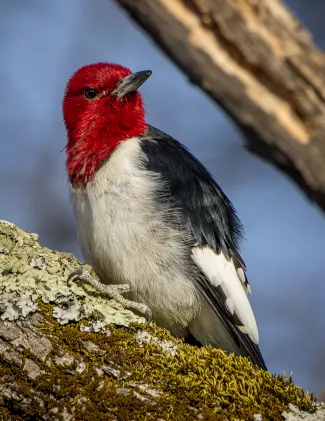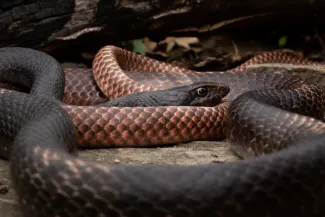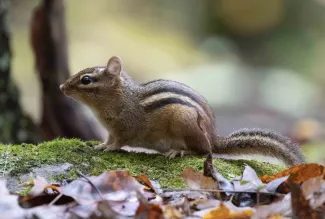As the daylight hours shorten in November and waves of cold fronts push temperatures lower, Oklahoma’s wildlife take their cue and begin preparations to survive the winter weather. From migration to hibernation, here’s a closer look at how Oklahoma’s wildlife outlast cold temperatures.
Survival Technique: Migration
Many of Oklahoma’s birds shift their geographic range with seasonal changes — some more drastically than others.
The red-headed woodpecker, common in northwestern Oklahoma during the summer, will move a few hundred miles from prairie riparian habitats to the oak forests of eastern Oklahoma to fulfill their winter diet of acorns.

Red-headed woodpecker.
Other birds, such as scissor-tailed flycatchers, are considered neotropical migrants and travel thousands of miles from their nesting sites in North America to wintering grounds in Central and South America. During this journey, birds may face long flights over water with no stopovers, along with bad weather and little or unknown food sources. For birds making long-distance treks, building fat reserves is critical. Some gain 15 – 40% of their body weight prior to the biannual migration.
While Oklahoma’s winter may be too harsh for some birds, others take refuge in our state. Northern harriers, brown creepers and many sparrows escape the harsh winters of northern states for Oklahoma’s milder climate. Those birds enduring Oklahoma’s winters have less competition for depleting native berry and seed sources, and often join mixed-species winter flocks for warmth.
Survival Technique: Hunker Down
Other wildlife species are less mobile than birds and cannot fly south to avoid cold temperatures. Salamanders, turtles and other reptiles and amphibians are especially vulnerable, as their body temperatures fluctuate with the environment. To survive, they must overwinter at sites that remain above freezing.

Coachwhip.
Snakes often gather in natural cavities such as rock crevices or rodent burrows with favorable thermal conditions. Multiple species of snakes may congregate in long-established “hibernacula” but will occasionally emerge to take advantage of warmer winter days.
Many turtles avoid the cold by burrowing below the frost line – 18 – 20 inches in central Oklahoma – or lying inactive on the bottom of rivers or streams. Several amphibians also remain underwater the entire winter and may gather in large groups. Frogs, including chorus and treefrogs, can survive on land in shallow depressions covered in leaf litter. These frogs require a special adaptation to survive: a biochemical “antifreeze” in their bodies that protects their cells from rupturing when temperatures drop below freezing.
Survival Technique: Stash It, Fluff It, Den it
Mammals are also vulnerable to falling temperatures but have several defenses. In addition to being able to regulate their body temperature, they often store food; fluff up hair or fur to minimize heat loss; build nests or dens to retain heat; or reduce metabolic rates and body temperatures to enter a state of dormancy.

Eastern chipmunk.
Some mammals, such as the eastern chipmunk, are only inactive for short periods. Others, such as the thirteen-lined ground squirrel, lower their body temperature and metabolism, and are considered “true hibernators.” This striped rodent hibernates for an average of 240 days of the year!
Winter can be a trying time for many of our wildlife species. Consider maintaining a bird feeder or installing a brush pile for your backyard visitors. Other ways to make your backyard more wildlife friendly can be found in our book “Landscaping for Wildlife: A Guide to the Southern Great Plains.”